Bound to shock: protection from lethal endotoxemic shock by a novel, nontoxic, alkylpolyamine lipopolysaccharide sequestrant
- PMID: 17548488
- PMCID: PMC1932507
- DOI: 10.1128/AAC.00200-07
Bound to shock: protection from lethal endotoxemic shock by a novel, nontoxic, alkylpolyamine lipopolysaccharide sequestrant
Abstract
Lipopolysaccharide (LPS), or endotoxin, a structural component of gram-negative bacterial outer membranes, plays a key role in the pathogenesis of septic shock, a syndrome of severe systemic inflammation which leads to multiple-system organ failure. Despite advances in antimicrobial chemotherapy, sepsis continues to be the commonest cause of death in the critically ill patient. This is attributable to the lack of therapeutic options that aim at limiting the exposure to the toxin and the prevention of subsequent downstream inflammatory processes. Polymyxin B (PMB), a peptide antibiotic, is a prototype small molecule that binds and neutralizes LPS toxicity. However, the antibiotic is too toxic for systemic use as an LPS sequestrant. Based on a nuclear magnetic resonance-derived model of polymyxin B-LPS complex, we had earlier identified the pharmacophore necessary for optimal recognition and neutralization of the toxin. Iterative cycles of pharmacophore-based ligand design and evaluation have yielded a synthetically easily accessible N(1),mono-alkyl-mono-homologated spermine derivative, DS-96. We have found that DS-96 binds LPS and neutralizes its toxicity with a potency indistinguishable from that of PMB in a wide range of in vitro assays, affords complete protection in a murine model of LPS-induced lethality, and is apparently nontoxic in vertebrate animal models.
Figures

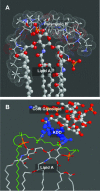
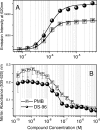
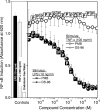
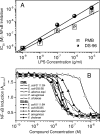
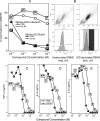
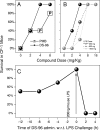

Similar articles
-
Polymyxin B: an ode to an old antidote for endotoxic shock.Mol Biosyst. 2005 Sep;1(3):213-22. doi: 10.1039/b500756a. Epub 2005 Jul 29. Mol Biosyst. 2005. PMID: 16880985 Review.
-
Development of small-molecule endotoxin sequestering agents.Subcell Biochem. 2010;53:255-83. doi: 10.1007/978-90-481-9078-2_12. Subcell Biochem. 2010. PMID: 20593271
-
Protection from endotoxic shock by EVK-203, a novel alkylpolyamine sequestrant of lipopolysaccharide.Bioorg Med Chem. 2007 Sep 1;15(17):5694-709. doi: 10.1016/j.bmc.2007.06.015. Epub 2007 Jun 10. Bioorg Med Chem. 2007. PMID: 17583517 Free PMC article.
-
Lysine-spermine conjugates: hydrophobic polyamine amides as potent lipopolysaccharide sequestrants.Bioorg Med Chem. 2005 Apr 1;13(7):2523-36. doi: 10.1016/j.bmc.2005.01.038. Bioorg Med Chem. 2005. PMID: 15755654
-
Towards a rational development of anti-endotoxin agents: novel approaches to sequestration of bacterial endotoxins with small molecules.J Mol Recognit. 2001 Nov-Dec;14(6):370-87. doi: 10.1002/jmr.549. J Mol Recognit. 2001. PMID: 11757070 Review.
Cited by
-
Potent adjuvanticity of a pure TLR7-agonistic imidazoquinoline dendrimer.PLoS One. 2012;7(8):e43612. doi: 10.1371/journal.pone.0043612. Epub 2012 Aug 28. PLoS One. 2012. PMID: 22952720 Free PMC article.
-
Biophysical mechanisms of the neutralization of endotoxins by lipopolyamines.Open Biochem J. 2013 Sep 30;7:82-93. doi: 10.2174/1874091X01307010082. eCollection 2013. Open Biochem J. 2013. PMID: 24133550 Free PMC article.
-
Structure-activity relationships of antimicrobial and lipoteichoic acid-sequestering properties in polyamine sulfonamides.Antimicrob Agents Chemother. 2009 Jan;53(1):57-62. doi: 10.1128/AAC.00812-08. Epub 2008 Oct 27. Antimicrob Agents Chemother. 2009. PMID: 18955537 Free PMC article.
-
Structure--activity relationships of polymyxin antibiotics.J Med Chem. 2010 Mar 11;53(5):1898-916. doi: 10.1021/jm900999h. J Med Chem. 2010. PMID: 19874036 Free PMC article. Review. No abstract available.
-
Bacterial cell wall compounds as promising targets of antimicrobial agents I. Antimicrobial peptides and lipopolyamines.Curr Drug Targets. 2012 Aug;13(9):1121-30. doi: 10.2174/138945012802002410. Curr Drug Targets. 2012. PMID: 22664072 Free PMC article.
References
-
- Beamer, L. J., S. F. Carroll, and D. Eisenberg. 1999. The three-dimensional structure of human bactericidal/permeability-increasing protein: implications for understanding protein-lipopolysaccharide interactions. Biochem. Pharmacol. (Oxford) 57:225-229. - PubMed
-
- Bhattacharjya, S., S. A. David, V. I. Mathan, and P. Balaram. 1997. Polymyxin B nonapeptide: conformations in water and in the lipopolysaccharide-bound state determined by two-dimensional NMR and molecular dynamics. Biopolymers 41:251-265.
-
- Bone, R. C. 1996. The sepsis syndrome. Definition and general approach to management. Clin. Chest Med. 17:175-181. - PubMed
-
- Burns, M. R., S. A. Jenkins, S. J. Wood, K. Miller, and S. A. David. 2006. Structure-activity relationships in lipopolysaccharide neutralizers: design, synthesis, and biological evaluation of a 540-membered amphipathic bisamide library. J. Comb. Chem. 8:32-43. - PubMed
-
- Burns, M. R., S. J. Wood, K. A. Miller, T. Nguyen, J. R. Cromer, and S. A. David. 2005. Lysine-spermine conjugates: hydrophobic polyamine amides as potent lipopolysaccharide sequestrants. Bioorg. Med. Chem. 13:2523-2536. - PubMed
Publication types
MeSH terms
Substances
Grants and funding
LinkOut - more resources
Full Text Sources
Other Literature Sources
Medical

